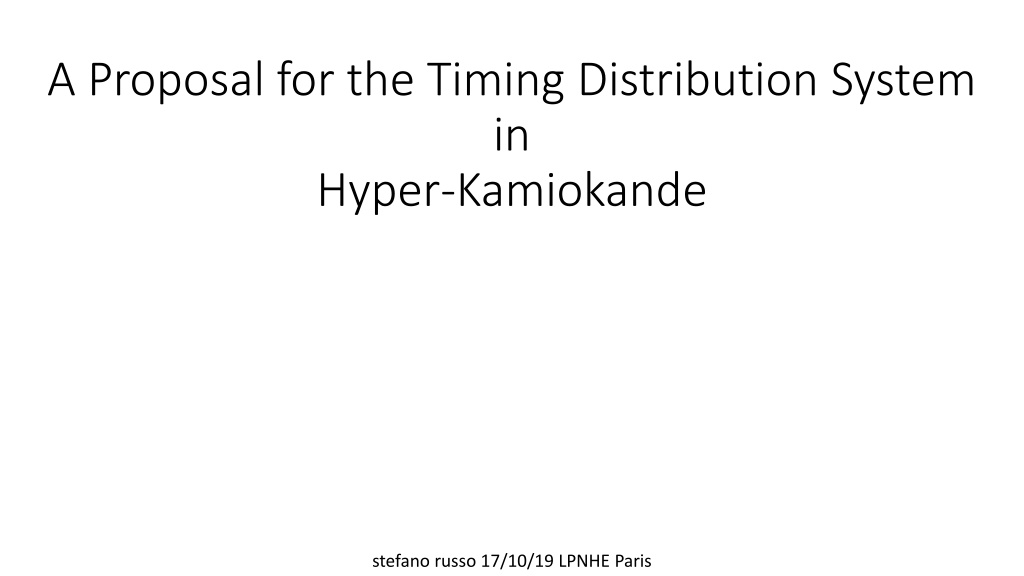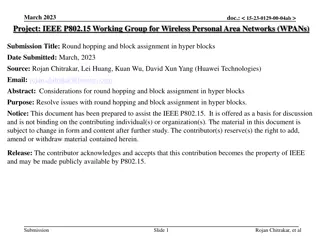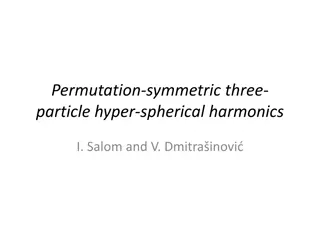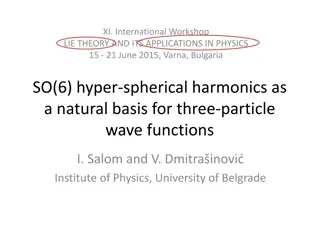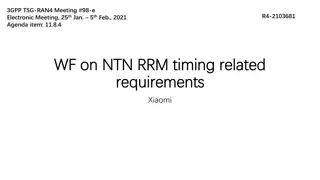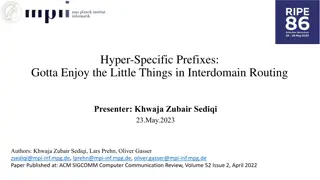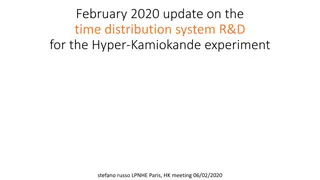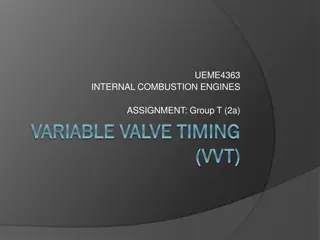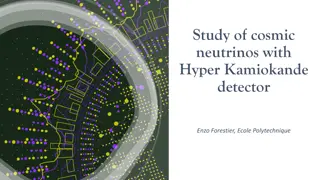Proposal for Timing Distribution System in Hyper-Kamiokande
A proposal for a timing distribution system in the Hyper-Kamiokande project, focusing on implementing a synchronous, phase-deterministic protocol with bidirectional data exchange. The system includes a master clock generator, atomic clock, and multiple distributors to synchronize various components. Research and development have begun, exploring solutions like CERN White Rabbit for gigabit Ethernet-based data and time distribution. The project aims to serve a large number of nodes, including PMTs and front-end modules, with minimal bandwidth requirements for synchronization.
Download Presentation

Please find below an Image/Link to download the presentation.
The content on the website is provided AS IS for your information and personal use only. It may not be sold, licensed, or shared on other websites without obtaining consent from the author.If you encounter any issues during the download, it is possible that the publisher has removed the file from their server.
You are allowed to download the files provided on this website for personal or commercial use, subject to the condition that they are used lawfully. All files are the property of their respective owners.
The content on the website is provided AS IS for your information and personal use only. It may not be sold, licensed, or shared on other websites without obtaining consent from the author.
E N D
Presentation Transcript
A Proposal for the Timing Distribution System in Hyper-Kamiokande stefano russo 17/10/19 LPNHE Paris
Schematic diagram of the synchronization system 1pps (timecode) GPS receiver Clock, counter and control signal distributor #1 External control signals (NIM level), reset etc. 1pps Clock Counter and Control sig. Master clock generator Atomic clock (Rb) 10MHz clk Status monitor (computer) Clock, counter and control signal distributors #2 (incl. response data handler + LV (48V) power supply) Clock, counter and control signal distributors #2 (incl. response data handler + LV (48V) power supply) ~41 distributors connected to status monitor clock, counter and control sig. (opt. fiber) Response (ACK/status, # of hits etc.) (opt. fiber) DC(48V) ~48 units HK Tank Front-end Front-end electronics module Front-end Front-end 48 front-end elec. modules are connected to 1 distributor There will be ~41 distributors #2. (#1 and #2 could be identical) From Yoshinari Hayato for WG4 presentation
What Do We Need? The requirements calls for a bidirectional data exchange link The requested bandwidth seams low (not exactly defined yet) Extra bandwidth can be useful The goal is to implement a synchronous, phase deterministic protocol with as large as possible bandwidth
How Do We Implement it? R&D already started! Many solutions are under consideration but 2 of them seam promising CERN White Rabbit Custom solution
How Many Nodes? HK PMTs numerology : 8k large single PMT in the outer detector 20k large single PMT in the inner detector Up to 20K multi-PMT spheres in the inner detector HK FE numerology : Each Front-End gathers signals from 25 PMTs 320 FE for the outer detector 800 FE for the large PMTs inner detector 800 FE for the multi-PMTs inner detector
CERN White Rabbit Fully deterministic gigabit ethernet-based solution to distribute data and time Single master many slaves The master receives GPS s signals, generate a clock and distributes it Propagation delay actively compensated Synchronization requires very few bandwidth (~400 Bps) White Rabbit node can talk with standard ethernet nodes 18 ports white rabbit switches are of-the-shelf CERN distributes hardware and firmware design and support them
CERN White Rabbit A possible architecture 8 links 8 links DAQ WR switch WR switch FE FE FE FE 25 25 25 25 8 8
Custom Solution Based on FPGA s ser-des fixed phase locking system Point-to-point Each master can receive GPS s signals or signal from clock fanout generate a clock and distributes it Synchronization doesn t require any data bandwidth Slave s clock phase delay is proportional to the signal propagation Custom FE link with tailored bandwidth DAQ link is standard (i.e. 10Gbps ethernet) Concentrator connections depends on the requested bandwidth Hardware and firmware design is custom
Custom Solution A possible architecture (assuming 1Gbps to FE) 10 Gbps Eth 10 Gbps Eth DAQ Alternative CLK fanout Custom Concentrator Custom Concentrator FE FE FE FE 25 25 25 25 8 8
Cost Estimation Total cost is calculated adding 20% contingency and 20% spares White Rabbit Custom Solution 28.000 large PMTs (inner + outer) 28.000 large PMTs (inner + outer) (1.120/8) x 5.300 = 742.000 euro 4.000 multi-PMT (1.120/8) x 4.000 = 560.000 euro 4.000 multi-PMT (160/8) x 5.300 = 106.000 euro 20.000 multi-PMT (160/8) x 4.000 = 80.000 euro 20.000 multi-PMT (800/8) x 5.300 = 530.000 euro (800/8) x 4.000 = 400.000 euro TOTAL COST Baseline: 1.038.800 euro Extra 4.000 multiPMT: 148.400 euro Extra 20.000 multiPMT: 742.000 euro TOTAL COST Baseline: 784.800 euro Extra 4.000 multiPMT: 112.400 euro Extra 20.000 multiPMT: 560.000 euro
Summary White Rabbit Custom Solution Pros Very good timing distribution performances. Very reliable since is developed and supported by CERN. Cons Higher price Pros Link tailored to the experiment s needs. Lower price. Cons Design process is time consuming and prone to delay.
